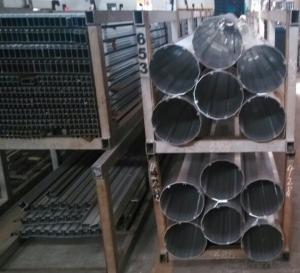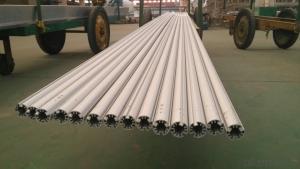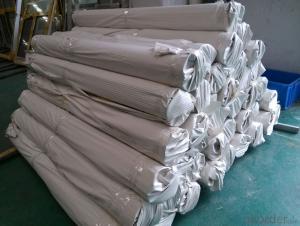Aluminium Alloy Tube Profile used on Furnitures
- Loading Port:
- Shanghai
- Payment Terms:
- TT OR LC
- Min Order Qty:
- 5 m.t.
- Supply Capability:
- 500 m.t./month
OKorder Service Pledge
OKorder Financial Service
You Might Also Like
Products Description
Item | Aluminium Pipe / Aluminum Tube |
Standard | ASTM B209-04,B210M-05,B234M-04,B241-02,B221M-05a, AISI, SUS, EN573-3-2003, JISH4000-2006,H4080-2006, H4040-2006, DIN, GB/T3190-2008,3880.1-2006, 6893-2000,3191-1998,4437.1-2000, ASME,ISO3522-1984 |
ISO ASTM JIS Standard | 1000series:1435,1050,1060,1070,1080,1100,etc |
2000series:2011,2014,2017,2024,etc | |
3000series:3002,3003,3104,3204,3030,etc | |
| 5000series:5005,5025,5052,5040,5056,5083,etc | |
6000series:6101,6003,6061,6063,6020,6201,6262,6082,etc | |
7000series:7003,7005,7050,7075,etc | |
GB Standard | 1A80,1070A,1100,2A01,2014A,1017A,5050,5154A,5083,6161, 7A01,7A52,7075, |
Surface | mill,polished,bright,hair line,brush |
Thickness | 0.5-150mm |
Diameter | 2-2500mm |
Length | 1-12m ,or as required |
Application | 1. Lighting,solar reflector plate. 2.architectural appearance, interior decoration:ceiling,metope, furniture,cabinets and so on. 3.elevator,nameplate, bags. 4.automotive interior and exterior decoration. 5. Interior decoration: such as photo frame. 6.household appliances, refrigerator, microwave oven, audio equipment. 7. Aerospace and military aspects. 8, machinery parts processing, mold manufacturing . 9. chemical/insulation pipeline coating. |
Payment terms | T/T, L/C, and Western Union |
Price terms | FOB CIF CFR CNF etc |
Delivery time | Normally according to the order quantity |
- Q:The original aluminum is silver, but now the market has black, yellow and green, aluminum radiator, radiator is the color what are formed by oxidation of different colors, what are the benefits of it, are used in the above types of products?
- As for the coating and metal coating materials processing as the first surface degreasing and coarsening process, then spraying or cathodic electrophoresis mode is used in aluminum surface with a layer of film, choose different properties and color of paint can make the aluminum surface to obtain the corresponding protection performance.
- Q:Are aluminum profiles suitable for automotive body panels?
- Yes, aluminum profiles are suitable for automotive body panels. Aluminum is a lightweight and strong material, making it ideal for improving fuel efficiency and enhancing overall vehicle performance. Additionally, aluminum profiles offer excellent corrosion resistance, durability, and design flexibility, making them a popular choice for modern automotive applications.
- Q:How can the aluminum profile T6 and T5 be distinguished?
- Hardness is generally measured by a Brinell hardness tester. T5 is subjected to high temperature molding and air cooling quenching in the shortest possible time. The T6 is treated with solid solution after artificial aging. So there is a difference between the two. But from the appearance of it is difficult to judge, experienced hands can be used to swing aluminum, roughly judged
- Q:Can aluminum profiles be used for automotive roof racks or cargo systems?
- Yes, aluminum profiles can be used for automotive roof racks or cargo systems. Aluminum is a lightweight yet strong material that is commonly used in the automotive industry. It offers good corrosion resistance and can withstand various weather conditions, making it suitable for outdoor applications such as roof racks and cargo systems. Additionally, aluminum profiles can be easily customized and designed to meet specific requirements, making them a popular choice for these applications.
- Q:How do you ensure proper weatherproofing with aluminum profiles?
- To ensure proper weatherproofing with aluminum profiles, there are several key measures that can be taken. Firstly, it is important to select high-quality aluminum profiles that are specifically designed for weather resistance. These profiles should be treated with a suitable finish or coating that provides protection against corrosion and weather elements. Next, proper installation techniques should be followed to ensure a tight and secure fit. This includes ensuring that the profiles are correctly aligned and joined together using appropriate fasteners or adhesives. Any gaps or openings between the profiles should be sealed with weatherproofing materials such as silicone or rubber gaskets to prevent water or air infiltration. In addition, it is crucial to pay attention to the design and construction of the aluminum profiles. This involves incorporating features like sloped surfaces, drip edges, and drainage systems to facilitate water runoff and prevent pooling or accumulation. Adequate provisions should also be made to address thermal expansion and contraction, which can affect the weatherproofing performance of the profiles. Regular maintenance is another important aspect in ensuring long-lasting weatherproofing. Periodic inspections should be conducted to identify any signs of wear, damage, or deterioration in the profiles or their weatherproofing elements. Any issues should be promptly addressed through repairs or replacement to maintain the integrity of the weatherproofing system. Overall, by selecting quality aluminum profiles, following proper installation techniques, incorporating suitable design features, and conducting regular maintenance, one can ensure proper weatherproofing with aluminum profiles and enhance their durability and performance against weather elements.
- Q:the middle of the following is a groove structure, as if you can not bolt hole, then how to install the rail on it? What's the use of flat sealing strips and slip bars embedded inside? Is it necessary to mount the guide rail on the aluminum profile, you can choose more than 6060 of the profiles, the middle is flat structure, and then drill holes in the bolt connection rail Thanks
- Use the T nut (in the T groove) to fit the rail, the flat sealing strip, and the slip bar embedded in it for dust, waterproof, oil proof and so on.Guide (TTW): metal or other materials made of grooves or ridges, can withstand, fixed, and guide the movement of devices or equipment, and reduce its friction of a device.
- Q:Are there any safety considerations when working with aluminum profiles?
- Yes, there are several safety considerations when working with aluminum profiles. Firstly, aluminum dust and chips can be combustible, so it is important to have proper ventilation and avoid creating sparks or heat sources near the material. Additionally, aluminum profiles can have sharp edges or burrs, which can cause cuts or injuries if not handled carefully. It is advisable to wear appropriate personal protective equipment such as gloves, safety glasses, and a dust mask to prevent any potential hazards.
- Q:How are aluminum profiles joined together?
- Depending on the desired strength, functionality, and aesthetic appeal, various methods can be employed to join aluminum profiles. The most commonly utilized techniques include mechanical fastening, welding, and adhesive bonding. When it comes to ease of assembly and disassembly, mechanical fastening is a preferred option. Screws, bolts, nuts, rivets, and self-tapping screws are frequently employed to connect aluminum profiles, ensuring a stable and secure joint that allows for easy adjustment or dismantling. Welding, on the other hand, presents an effective means of joining aluminum profiles. Techniques such as TIG (Tungsten Inert Gas) or MIG (Metal Inert Gas) can be applied to melt and fuse the profiles together, resulting in a strong and permanent joint. Welding finds common usage in structural applications where high strength and rigidity are imperative. For a more visually appealing connection, adhesive bonding is often employed. Industrial-grade adhesives specifically formulated for aluminum bonding create a robust bond between the profiles. This method offers a seamless appearance, with no visible fasteners or weld marks. Adhesive bonding is commonly utilized in architectural applications, where a clean and sleek finish is desired. In certain instances, a combination of these methods may be employed to achieve the desired joint. For example, adhesive bonding can secure the profiles together, while mechanical fasteners provide additional strength and stability. Ultimately, the choice of joining method is contingent upon factors such as the application, required strength, accessibility, and desired appearance. Manufacturers and fabricators meticulously consider these factors to determine the most suitable method for joining aluminum profiles.
- Q:What are the different tolerance levels for aluminum profiles?
- The tolerance levels for aluminum profiles can vary depending on the specific application and requirements. However, some common tolerance levels for aluminum profiles include dimensional tolerances, such as length, width, and thickness variations, as well as straightness, flatness, and surface finish tolerances. These tolerances ensure the desired precision and consistency in the manufacturing and assembly of aluminum profiles.
- Q:What are the different surface treatments for aluminum profiles?
- There are several different surface treatments available for aluminum profiles, each offering unique benefits and characteristics. Some of the most common surface treatments for aluminum profiles include anodizing, powder coating, painting, and brushing. Anodizing is a popular surface treatment method that involves creating a protective oxide layer on the aluminum surface. This process enhances the corrosion resistance of the aluminum, making it suitable for outdoor applications. Anodized aluminum profiles are also known for their aesthetic appeal, as they can be dyed in various colors for a sleek and modern finish. Powder coating is another widely used surface treatment technique for aluminum profiles. It involves applying a dry powder paint onto the aluminum surface, which is then cured under heat to create a durable coating. Powder-coated aluminum profiles offer excellent resistance to scratching, chipping, and fading, making them ideal for applications that require long-lasting and vibrant finishes. Painting is a versatile surface treatment option that allows for a wide range of color choices and finishes. Aluminum profiles can be painted using various methods, such as spray painting or electrostatic coating. Painted aluminum profiles provide a smooth and attractive appearance, suitable for both indoor and outdoor applications. Brushing is a surface treatment technique that involves brushing the aluminum surface with a wire brush or abrasive material. This process creates a textured finish, giving the aluminum a distinctive and decorative look. Brushed aluminum profiles are often chosen for architectural and design applications that require a unique and stylish appearance. Overall, the choice of surface treatment for aluminum profiles depends on the specific requirements of the application. Factors such as corrosion resistance, durability, aesthetic appeal, and functionality play a crucial role in determining the most suitable surface treatment method for aluminum profiles.
1. Manufacturer Overview |
|
|---|---|
| Location | |
| Year Established | |
| Annual Output Value | |
| Main Markets | |
| Company Certifications | |
2. Manufacturer Certificates |
|
|---|---|
| a) Certification Name | |
| Range | |
| Reference | |
| Validity Period | |
3. Manufacturer Capability |
|
|---|---|
| a)Trade Capacity | |
| Nearest Port | |
| Export Percentage | |
| No.of Employees in Trade Department | |
| Language Spoken: | |
| b)Factory Information | |
| Factory Size: | |
| No. of Production Lines | |
| Contract Manufacturing | |
| Product Price Range | |
Send your message to us
Aluminium Alloy Tube Profile used on Furnitures
- Loading Port:
- Shanghai
- Payment Terms:
- TT OR LC
- Min Order Qty:
- 5 m.t.
- Supply Capability:
- 500 m.t./month
OKorder Service Pledge
OKorder Financial Service
Similar products
New products
Hot products
Related keywords
































